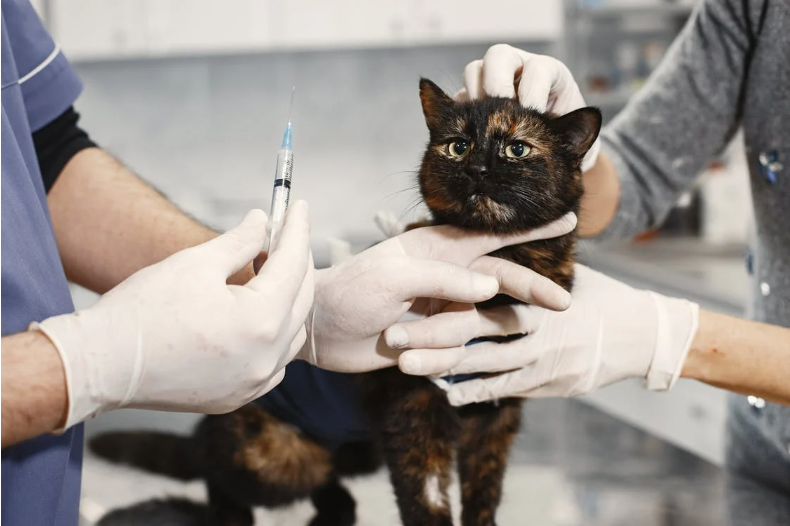It’s the middle of summer, and that means that bug season is in full swing. Bugs of all sorts can make their way into your house and onto your skin, leaving you with itchy red bumps. While most humans are concerned about pesky mosquito bites, there is a whole other category of bugs that can cause serious health problems: ticks. Ticks can transmit several diseases to both humans and cats. Understand the different types of tick-borne diseases your cat can suffer from and the signs of illness they can cause.

Most Common Types of Tick-Borne Disease in Cats
Lyme Disease
Lyme disease is an infection caused by a bacterium that is spread through the bite of the black-legged (deer) tick. This tick is often found in the eastern United States, as well as in Texas and South Dakota.
Lyme disease can cause a variety of symptoms in cats, including:
- Fever
- Joint pain
- Lethargy
- In some cases, cats may also develop anemia or kidney disease.
If you think your cat may have Lyme disease, it is important to take them to the vet for a diagnosis and treatment. Lyme disease can be difficult to treat, but with early intervention and proper care, most cats make a full recovery.
Hepatozoonosis
Cats can also be infected with a tick-borne disease called hepatozoonosis. Unlike most tick-borne diseases, hepatozoonosis is not transmitted through a tick bite but through the carnivore ingesting an infected tick.The parasite invades and resides in the organs and muscle tissue of the carnivorous host animal, where it divides and ruptures cells, and enters the bloodstream. Once in the bloodstream, it can be taken up by a biting tick, infecting the tick, and repeating the cycle.
Symptoms of hepatozoonosis that you need to watch for can include:
- Fever
- Depression
- Weight loss
- Muscle weakness
- Swollen lymph nodes
Tularemia
Often referred to as rabbit fever, tularemia is a bacterial disease caused by Francisella tularensis. Most commonly, tularemia is found in rabbits and rodents, and it causes tumor-like masses and abscesses in the liver.
It is uncommon for cats to contract tularemia, but they can contract it by eating infected rabbits or rodents or by being bitten by insects.
Symptoms of Tularemia to watch out for in your cats:
- an acute illness with high fever (40 - 41°C; 104 - 106°F)
- large painful lymph nodes in the head and neck
- abdominal pain
- jaundice (yellowing of skin, mucous membranes, and the whites of the eyes),
- organ system failure.
Cats are typically treated with antibiotics for tularemia, and prevention involves avoiding contact with sick or dead rabbits and rodents and disposing of carcasses promptly. It is a zoonotic disease, which means it can be transmitted to humans and should be reported to the public health authorities.
Babesiosis (Piroplasmosis)
Babesiosis is a disease caused by a protozoan called Babesia felis. It is spread through tick bites, and cats are the most common hosts.
The disease is more common in Southern Africa, but it has not been reported in the United States.
Symptoms of babesiosis include:
- fever
- anemia
- and jaundice
If left untreated, the disease can be fatal. Treatment for babesiosis typically involves the use of antibiotics. In severe cases, cats may also require blood transfusions.
Anaplasmosis
Although not as susceptible as dogs, can become infected with Anaplasmosis. Cats typically contract the disease through a tick bite.
The most common symptom in cats is fever, which if left untreated, could lead to more serious health issues such as liver or kidney failure.
If you think your cat may have Anaplasmosis, contact your veterinarian right away. Early diagnosis and treatment is key to a successful recovery.
Cytauxzoonosis
Cytauxzoonosis is a protozoan infection that cats can contract from Lone Star ticks. The infection is found most commonly in the southern United States, but has also been found as far north as Wisconsin and Maine.
Symptoms of cytauxzoonosis include anemia, jaundice, fever, weakness, and lethargy. In severe cases, the disease can be fatal.
There is no specific treatment for cytauxzoonosis, so prevention is key.
Cats should be kept indoors to prevent them from coming into contact with ticks. Check your cat for ticks regularly and remove any you find if they’re coming from outside. Give your cat tick prevention, like GCP flea, tick, and mosquito deterrent soft chews, so you won't need to worry about them going outdoors.






